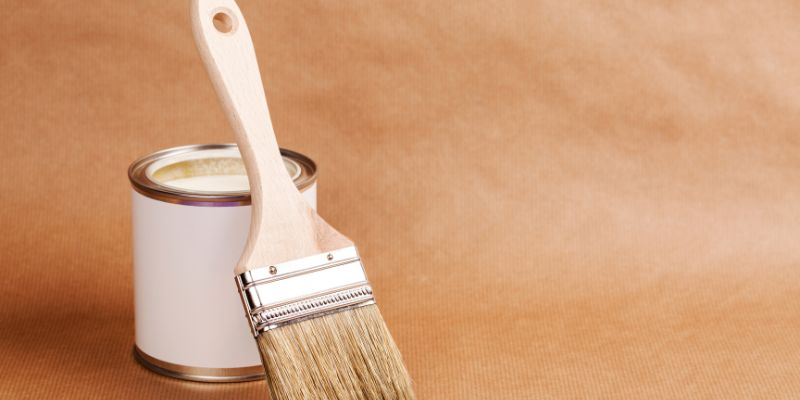No, you cannot mix paint with polyurethane. Mixing paint with polyurethane can affect the quality and durability of the finish.
When it comes to painting projects, it’s important to use the right materials for a professional and long-lasting result. One common question that arises is whether paint can be mixed with polyurethane. However, it is crucial to note that paint and polyurethane are different substances with distinct purposes.
Polyurethane is a clear protective coating used to seal and protect wood surfaces, while paint is a colored liquid used for decoration and coverage. Mixing the two can lead to unpredictable results, impacting the finish’s quality and durability. Therefore, it is recommended to use them separately to achieve the desired outcome for your painting project.
Understanding Paint And Polyurethane
When it comes to protecting and beautifying surfaces, two popular options frequently used are paint and polyurethane. Both serve distinct purposes and have unique properties that make them suitable for various applications. In this section, we will examine the key differences between paint and polyurethane, as well as their respective properties and uses.
Differentiating Paint And Polyurethane
Paint and polyurethane are often used interchangeably, but they are not the same. Understanding their individual characteristics is crucial in determining which is the best option for your specific project.
Paint is a liquid mixture that consists of pigments, resins, solvents, and additives. It forms a protective coating when applied to a surface and offers both color and protection against elements such as UV rays, moisture, and wear. Paint is available in various types, including oil-based paint, latex paint, and acrylic paint, each with its unique advantages and drying times.
Polyurethane, on the other hand, is a type of resin that can be either water-based or oil-based. It provides a hard, clear, and glossy finish over surfaces, protecting them from scratches, stains, and moisture. Polyurethane is commonly used on wooden surfaces, such as floors, furniture, and cabinets, to enhance their durability and appearance. Its strong protective properties make it an excellent choice for high-traffic areas.

Properties And Uses Of Paint
Paint offers a plethora of properties and is widely used in various applications. Some of the primary characteristics and uses of paint include:
- Color versatility: Paint comes in a wide range of colors, allowing for endless design possibilities and customization.
- Protection: Paint provides a protective barrier against harsh environmental conditions, such as sun, rain, and wind, preventing premature deterioration of surfaces.
- Decoration: Paint allows for artistic expression and adds visual appeal to surfaces, transforming dull spaces into vibrant and lively ones.
- Camouflage: Paint can be used to conceal imperfections and flaws, giving surfaces a smooth and flawless appearance.
- Surface adherence: Paint adheres well to a variety of materials, including wood, metal, concrete, and plastics, making it versatile for different surfaces.
Properties And Uses Of Polyurethane
Polyurethane possesses unique properties that make it a popular choice for certain applications. Here are some noteworthy characteristics and uses of polyurethane:
- Hard finish: Polyurethane forms a hard and durable surface that can withstand heavy use and resist scratches and stains, making it ideal for surfaces prone to wear and tear.
- Water resistance: Polyurethane has excellent water resistance, protecting surfaces from moisture damage, particularly when applied in bathrooms, kitchens, or outdoor areas.
- Glossy appearance: The application of polyurethane can result in a glossy, lustrous finish that enhances the natural beauty of wood and other materials.
- Chemical resistance: Polyurethane provides resistance against various chemicals, ensuring longevity even in environments exposed to chemical agents.
- Easy maintenance: Surfaces coated with polyurethane are relatively easy to clean and maintain, requiring minimal effort to keep them looking their best.
Mixing Paint With Polyurethane: Pros And Cons
When it comes to painting projects, mixing paint with polyurethane is a technique that has gained popularity. It can offer a range of benefits, but it also comes with a few drawbacks. In this article, we will explore the pros and cons of mixing paint with polyurethane to help you understand if it is the right choice for your next project.
Advantages Of Mixing Paint With Polyurethane
- Enhanced durability: One of the major advantages of mixing paint with polyurethane is the enhanced durability it provides. Polyurethane is known for its ability to withstand wear and tear, making the painted surface more resistant to scratches, stains, and other damage.
- Improved finish: Mixing paint with polyurethane can result in a smoother and more polished finish. The polyurethane acts as a protective layer, creating a professional-looking result that can elevate the overall appearance of your project.
- Resistance to moisture: Polyurethane is inherently water-resistant, making it an ideal choice for areas with high humidity or moisture. By mixing paint with polyurethane, you can add an extra layer of protection to your painted surface, preventing any water damage.
- Long-lasting color: When paint is mixed with polyurethane, it can improve the longevity of the color. The polyurethane acts as a barrier, helping to prevent fading or discoloration over time, ensuring that your painted project stays vibrant for longer.
Disadvantages Of Mixing Paint With Polyurethane
- Increased cost: Mixing paint with polyurethane can increase the overall cost of your project. Polyurethane is generally more expensive than paint alone, so it is important to consider your budget before deciding to mix the two.
- Additional time and effort: Adding polyurethane to your paint requires an extra step in the painting process. This means more time and effort spent on the project, as you will need to thoroughly mix the two substances and potentially apply multiple coats for optimal results.
- Possible inconsistency: When mixing paint with polyurethane, there is a risk of inconsistent results. It is crucial to ensure proper mixing and application to avoid any streaks, blotches, or uneven coverage that could detract from the final outcome.
- Strong odor: Polyurethane can emit a strong and potentially unpleasant odor during the application process. Proper ventilation is necessary to minimize the smell and avoid any discomfort while working on your project.
Now that you know the pros and cons of mixing paint with polyurethane, you can make an informed decision for your next painting project. Consider your specific needs and priorities to determine whether the advantages outweigh the disadvantages in your particular case.
Step-by-step Guide On How To Mix Paint With Polyurethane
Learn how to effectively mix paint with polyurethane in this step-by-step guide. Discover the secrets to achieving a seamless blend and creating a durable finish for your next project. Master the art of combining paint and polyurethane with ease.
Gathering The Necessary Materials
Before you can begin mixing paint with polyurethane, it’s important to gather all the necessary materials. Here’s what you’ll need:
- Paint – Choose a high-quality paint that is compatible with polyurethane. Make sure to select a paint color that complements your project.
- Polyurethane – Opt for a polyurethane that is suitable for the specific finish you desire, whether it’s matte, glossy, or satin.
- Measuring container – Use a measuring container with clear measurements to ensure accurate proportions when mixing the two substances.
- Stirring stick or paddle – A stirring stick or paddle is essential for thoroughly mixing the paint and polyurethane together.
- Clean cloth or brush – You’ll need a clean cloth or brush to apply the mixture onto your desired surface.
- Protective gear – To ensure your safety, wear protective gear such as goggles, a mask, and gloves while working with paint and polyurethane.
Prepping The Paint And Polyurethane
Properly preparing the paint and polyurethane is crucial for a successful mixture. Follow these steps to ensure your prep work is done correctly:
- Read the instructions – Before starting, carefully read the instructions provided by the paint and polyurethane manufacturers. This will provide insights into any specific requirements or recommendations for their products.
- Clean the surfaces – Ensure that the surfaces you plan to paint are clean, dry, and free from any dust or debris. Use a mild detergent and water solution to clean the surfaces if necessary.
- Protect surrounding areas – Cover any nearby furniture, floors, or objects that you want to keep paint-free from accidental splatters or spills.
- Mix the paint – If the paint has been sitting for a while, stir it well with a stick or paddle to ensure it’s thoroughly mixed. This step is important for achieving an even color.
- Measure the proportions – Carefully measure the desired ratio of paint to polyurethane using the measuring container. It’s recommended to follow the manufacturer’s recommendations for the specific products you’re using.
Mixing The Paint And Polyurethane
Once you have prepped the paint and polyurethane, it’s time to mix them together. Follow these steps for a proper mixture:
- Pour the paint – Pour the measured amount of paint into the mixing container. Use a funnel if necessary to avoid spills or waste.
- Add the polyurethane – Pour the measured amount of polyurethane into the same mixing container.
- Stir thoroughly – Use a stirring stick or paddle to thoroughly mix the paint and polyurethane together. Make sure to scrape the sides and bottom of the container to ensure all components are well combined.
- Check consistency – As you stir, observe the consistency of the mixture. If it appears too thick, you can add a small amount of water or paint thinner to thin it out.

Applying The Mixture
Now that you have successfully mixed the paint and polyurethane, it’s time to apply the mixture onto your desired surface. Follow these steps for effective application:
- Use a clean cloth or brush – Depending on the size and nature of your project, choose either a clean cloth or brush to apply the mixture. Ensure that the applicator is free from any paint residue.
- Apply in even strokes – Apply the mixture onto the surface using even strokes, working in the same direction for a smooth finish.
- Allow to dry – Follow the drying time recommended by the paint and polyurethane manufacturers. This will ensure that the mixture properly adheres and cures, providing a durable and attractive finish.
- Multiple coats (if required) – If necessary, apply additional coats of the mixture, allowing sufficient drying time between each coat.
- Clean up – Clean your tools and equipment with water or the appropriate solvent recommended by the paint and polyurethane manufacturers.
Frequently Asked Questions Of Can You Mix Paint With Polyurethane
Can You Add Polyurethane To Latex Paint?
Yes, you can add polyurethane to latex paint for added durability and protection. It will create a stronger, more durable finish that can withstand wear and tear.
Can I Add Color To Polyurethane?
Yes, you can add color to polyurethane. Mixing colorants or dyes with polyurethane allows you to create customized shades for your project. It’s important to choose colorants specifically made for use with polyurethane and follow proper mixing guidelines for the best results.
What Can I Mix With Polyurethane?
Polyurethane can be mixed with a catalyst, a thinner, or a pigment to enhance its properties.
Can You Put Polyurethane On the Paint?
Yes, you can apply polyurethane over paint as a protective finish. It provides durability, enhances gloss, and protects from scratches. Make sure the paint is fully dry and clean before applying the polyurethane. Consider sanding the surface lightly for better adhesion.
Conclusion
Mixing paint with polyurethane can be a viable option for achieving a glossy and durable finish on a variety of surfaces. However, it is crucial to ensure that the paint and polyurethane are compatible and properly mixed to avoid any potential issues.
It is always recommended to consult the manufacturer’s guidelines and conduct a test patch before proceeding with a full application. By taking these precautions, you can achieve professional-looking results and protect your painted surfaces effectively.


